



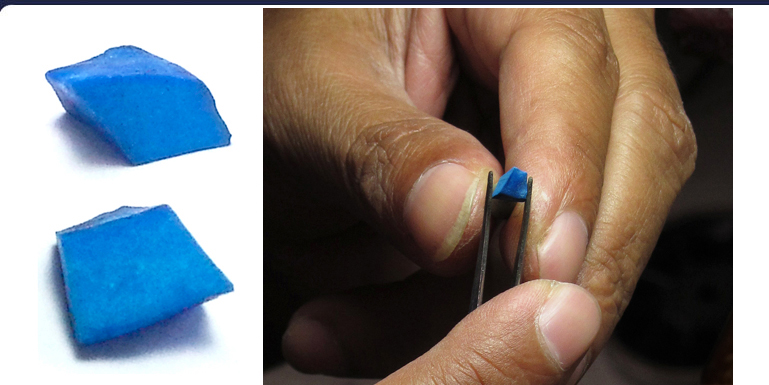
Resonance in Atlantean Geopolymer Chemistry
Sky Stone Identified as a Siloxonate Geopolymer Colored with Indigo Dye
by Alex Putney
March 14, 2018 - Updated March 30, 2018
Sophisticated cultural practices of the Atlantean civilization, including the use of hieroglyphic Paleo-Sanskrit script, persisted in South America throughout the rise and fall of indigenous societies in the Andean region until the genocidal Spanish Conquest that subverted the Inka people and their ancient ways. While a similar subversion occurred simultaneously during the African colonial holocaust, now known as the Maafa, various ancient cultural traditions inherited from the ancestral Atlantean civilization persist in West Africa to this day.
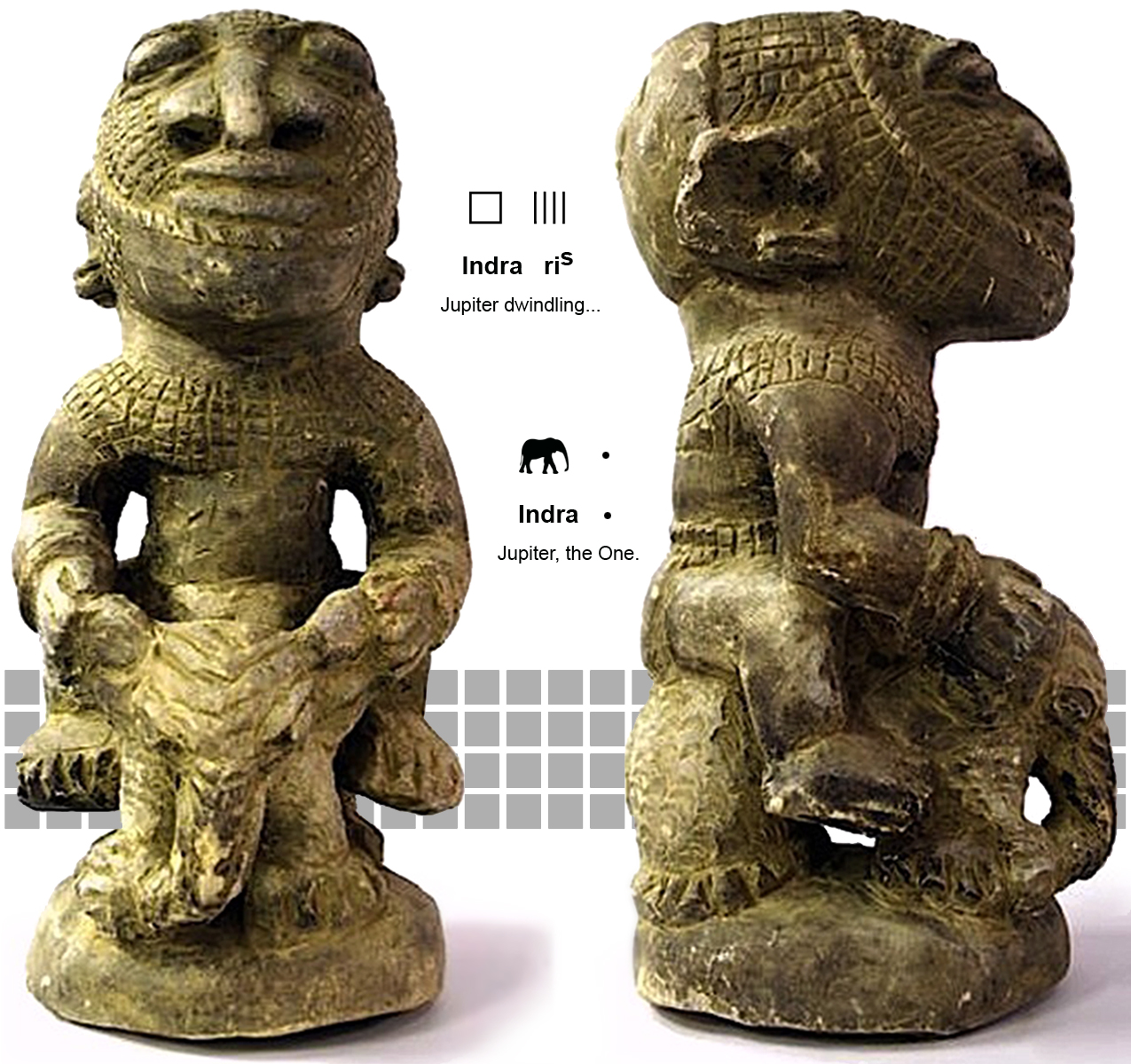
Traditional manufacture of large earthenware fermentation jars and vats is still practiced in Sierra Leone, a nation known for its ancient Paleolithic nomoli stone figures that have been dated to as far back as 19,000 years in age (above). The plasticity of form displayed among these small stone figures reveals they were not carved from natural stone, but were instead cast in ceramic molds using a geopolymer slurry of powdered steatite.
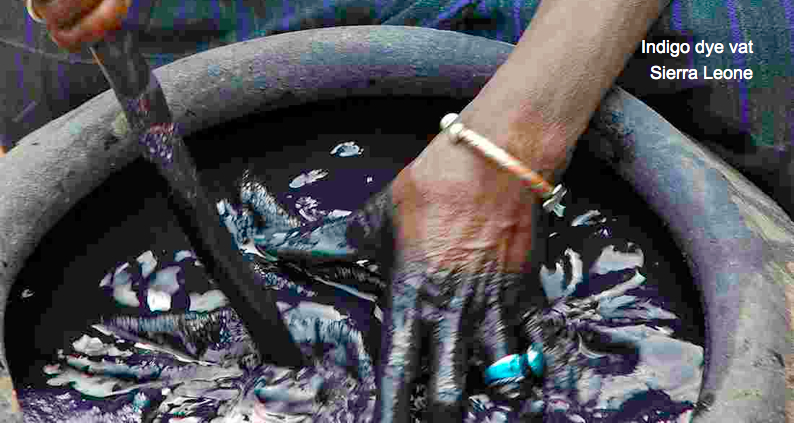
While Atlantean geopolymer casting techniques were not preserved among African indigenous cultures after the demise of the Atlantean civilization ~13,000 years ago, production of huge vats for fermentation of indigo leaves is still practiced in Sierra Leone, yielding indigo dye for the coloration of cotton cloth (above). Commonly called 'gara' in the Mandinka language, the Yoruba indigo shrub Philenoptera cyanescens is native to West Africa and requires processing with alkali agents also used in geopolymeric processes:
After harvesting, the leaves are soaked and then pounded into a pulp, transforming indican into indigotin, or indigo blue. This compound is not soluble in water, and therefore cannot bond with cloth. To change the compound so that it is water soluble, the pulp is added to water with some kind of alkali, traditionally wood ash, and left to ferment for a number of days. The fermentation process removes oxygen from the solution, transforming indigo blue to "indigo white", which is water soluble and capable of bonding with fiber. Cloth or yarn submerged in this solution will emerge yellow-green at first, but the indigo white soon oxidizes and it becomes indigo blue once again. When done properly, fabric dyed with indigo will maintain its color regardless of washing because the dye is no longer water-soluble.
Recognition of the geopolymer micro-tiles cast by gnomes at the Ohum pyramids of La Maná, Ecuador (below) has enabled definitive identification of unusually small synthetic stones discovered in other regions of the world, also found in close association with small earthen mounds hiding the diminutive pyramids of gnomes.
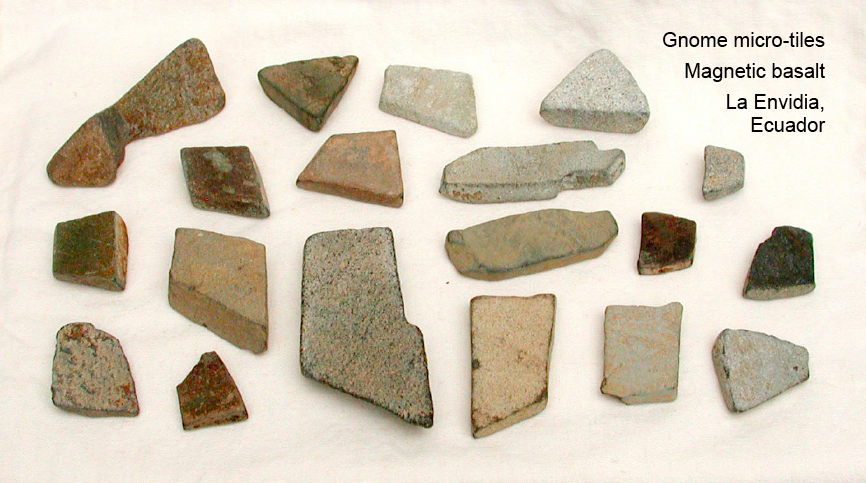
For decades, local residents digging in the vicinity of the ancient village of Kangbe, Sierra Leone, located south of the sprawling city of Freetown, have come across fragments of bright blue, semi-translucent stones that defy classification as any type of mineral known to science. Several of these highly unusual stone fragments found near Kangbe were kept by a local shaman for years before being shown to outsiders.
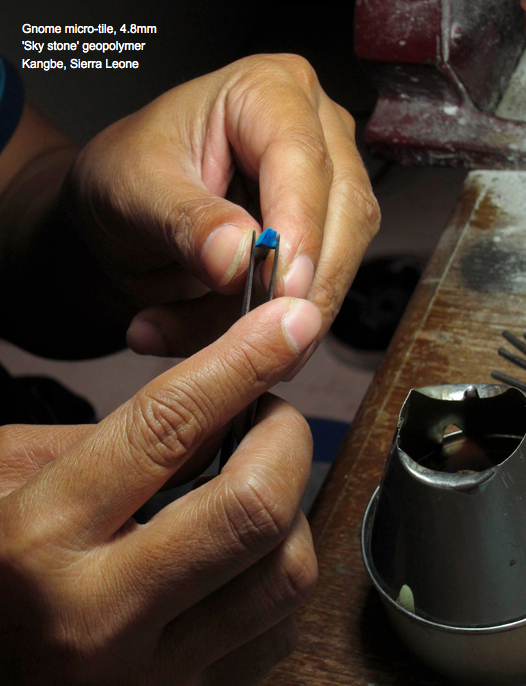
Along with several large fragments, the Kangbe shaman gave a tiny, nearly cubical sample (above) to Italian geologist and archeologist Angelo Pitoni during investigations in 1990. After resale through various gem dealers it was eventually purchased by Jared Collins, present owner of the sky stone sample. Relevant information concerning the artifact's provenance was provided to Collins by former owner Vijay Singh:
The piece of sky stone which you now have in your possession was discovered by a geologist and adventurer named Angelo Pitoni when he was in Sierra Leone. There, the indigenous population have a legend saying that "diamonds are stars which fell from the sky." Joking with them one day, Pitoni said: "but if the stars fell, then so too must the sky have fallen!" Their reply was: "Yes, and we know where it fell..."
A local shaman then brought him to a place where there were some pieces of this blue material on the ground. Digging into the ground, he found over 200kg of it which was not in a natural formation, but rather set in a pyramid shape. I was later shown photocopies of a report from geologists stating that the material could not be identified.
The clearly man-made symmetry of the 200kg sky stone pyramid confirms it was produced by the same technologically sophisticated, pyramid-building civilization that flourished during the Late Paleolithic Era, responsible for the construction of giant pyramid complexes in Egypt, Bosnia, Indonesia and Ecuador. Analysis of geometrically-shaped stone blocks and pavement tiles from these sites confirms their artificial origin as geopolymers, cast from a slurry of powdered stone, ash, sodium/potassium hydroxide and water.
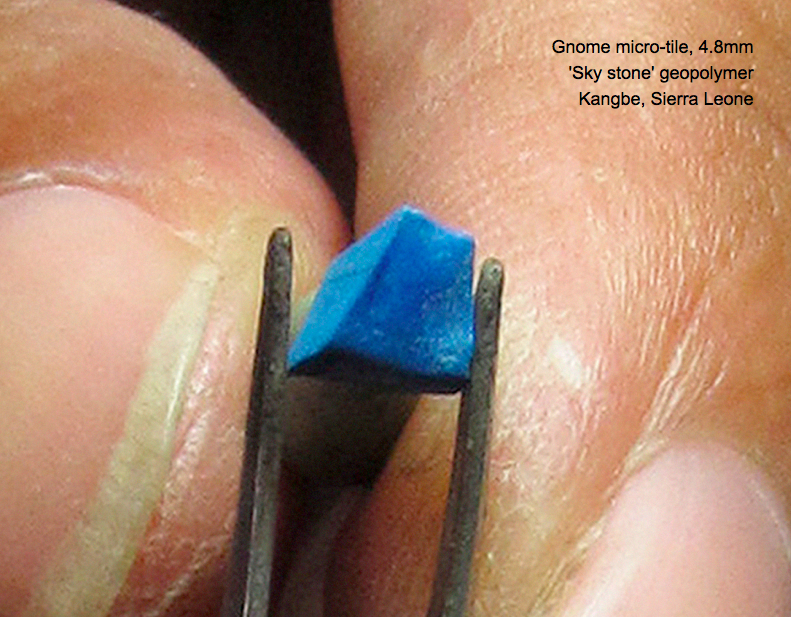
This minute sky stone sample is consistent with the form and scale of geopolymer micro-tiles cast by pixie gnomes as components of walkway pavements. In fact, geopolymer micro-tiles of the same size and shape have been discovered in streambeds below the Gnome Pyramid of Mist in La Envidia, Ecuador.
While the miniscule sky stone artifact's size and shape conform closely to the geopolymer casting patterns of Atlantean pavements from Ecuador, elemental composition of the synthetic sky-blue stone also confirms the geopolymeric origin of the material. Various world-class laboratories have conducted spectrographic analyses on the Kangbe sky stone micro-tile, revealing a surprisingly high oxygen content of 77.17%:
Tests of Sky Stone were carried out at laboratories of the University of Geneva, the University of Rome, Utrecht, Tokyo and Freiberg, Germany. Based on the fact that this material does not conform to any known natural minerals in existence, it is likely an artificial material. This beautiful blue colored stone with thin white veins running through it is known as 'Sky Stone' or 'Stone of Heaven.'
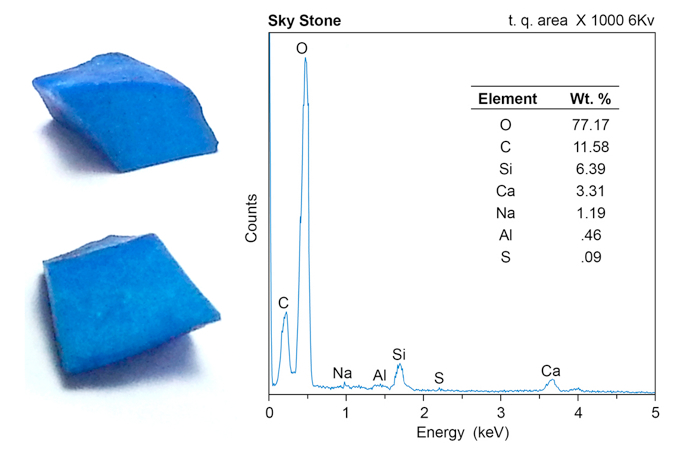
Its composition was found to be composed of 77% oxygen, along with traces of carbon, silicon, calcium and sodium. The composition makes the 'Sky Stone' similar to a kind of concrete or stucco, and seems to have been artificially colored. The natives living in the area [of Kangbe, Sierra Leone] where the stone was found, already knew about its existence because this stone-like artifact used to pop up during digging in the area.
Another mystery related to the Stone of Heaven is that this artifact is always found in soil layers dating to at least 12,000 BC. The stone was certainly produced by an unknown, highly advanced civilization lost in time.
These conclusive statements offered by materials scientists after analyzing the sky stone sample confirm its synthetic manufacture by an advanced civilization that is no longer lost in time, but has been positively identified as the global Paleo-Sanskrit motherculture of Atlantis. The many astounding mathematical, linguistic, and architectural achievements of the Atlanteans extend deep into subterran zones, blanketed by ~13,000 years of soil deposition that followed the catastrophic demise of Atlantis by meteor impacts.
Spectrography indicates that the sky stone micro-tile was cast from a silica-based geopolymer mixture consisting of rice husk ash (93% microsilica SiO2) and indigo pigment added to sodium hydroxide solution. Chemical analysis of the sky stone sample also revealed its unusually high resistivity to all acids, linking Atlantean production of sky stone geopolymer to the much later use of Maya blue paint in Mesoamerica.
Maya blue is a uniquely nanostructured organic-inorganic paint compound used by Maya artists in the creation of breathtaking ceramic glazes and brightly colored temple murals painted on plaster wall foundations. A recent study revealed how Maya blue is synthesized by absorbing indigo dye into finely ground palygorskite and sepiolite crystals, thereby endowing the paint with high acid resistivity.
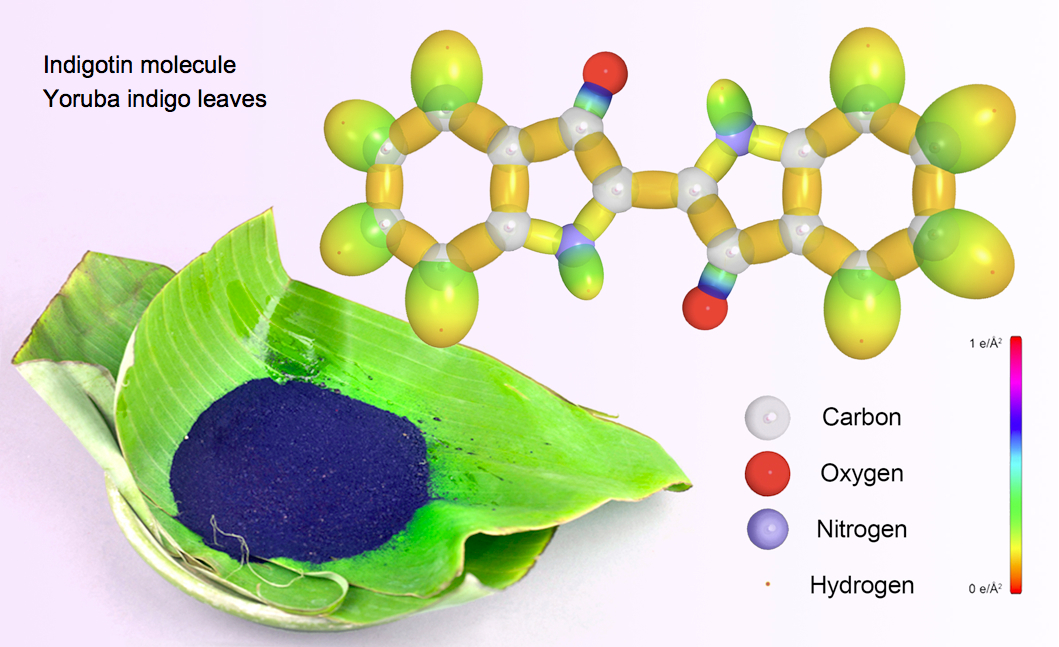
Sky stone geopolymer incorporates the same bright, sky-blue indigo pigment identified in the synthesis of Maya blue paint. Indigo dye is commonly used in the manufacture of blue jeans, with each pair requiring up to 12g of the pigment. The vibrant chemical pigment is called indigotin; a dark-blue, organic compound extracted from leaves of the Yoruba indigo shrub, Philenoptera cyanescens. Indigotin is a very stable molecule, being insoluble in water and most other solvents, and will not dissolve with heat or stirring.
The 11.58% carbon content of sky stone geopolymer is contributed by indigotin, which presents a molecular structure composed of a pair of carbon rings bound with oxygen, nitrogen and hydrogen atoms (above). During several hours required for the setting of geopolymers cast at ambient temperatures, indigotin dimers become fixed between the layered tetrahedral sheet silicate structure of sky stone: poly(siloxonate) [Si2O5] n.

While more common kaolin-based geopolymers display ratios of silicon to aluminum ranging from 1 to 3 (Si : Al 1-3), silica-based geopolymers display silicon to aluminum ratios greater than 5 (Si : Al > 5). The sky stone spectrograph identified 6.39% silicon and 0.46% aluminum --a ratio of over 12 (Si : Al = 12.6), further confirming the gepolymeric origin of sky stone as a caustic slurry of microsilica and indigo powders.
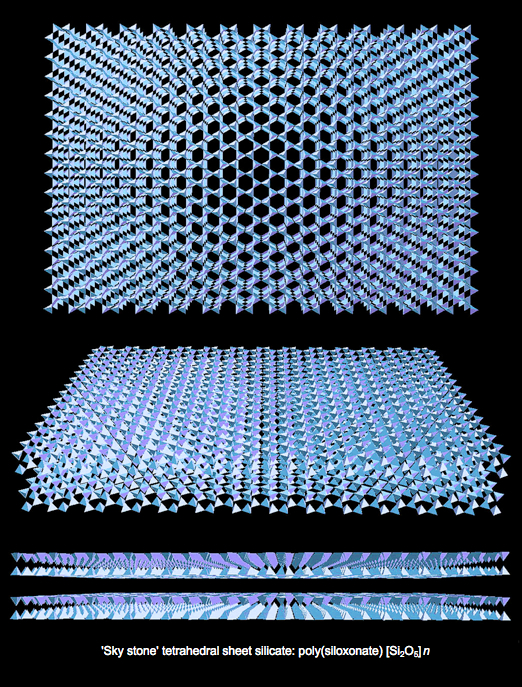
The largest sample of sky stone obtained from Kangbe presents the distinctive orange/yellow coloration of kaolinitic geopolymer cement adhering to the surface of the fragment (below). This orange geopolymer cement was used at all Atlantean temples worldwide to fix each cast stone block or tile to adjacent ones.
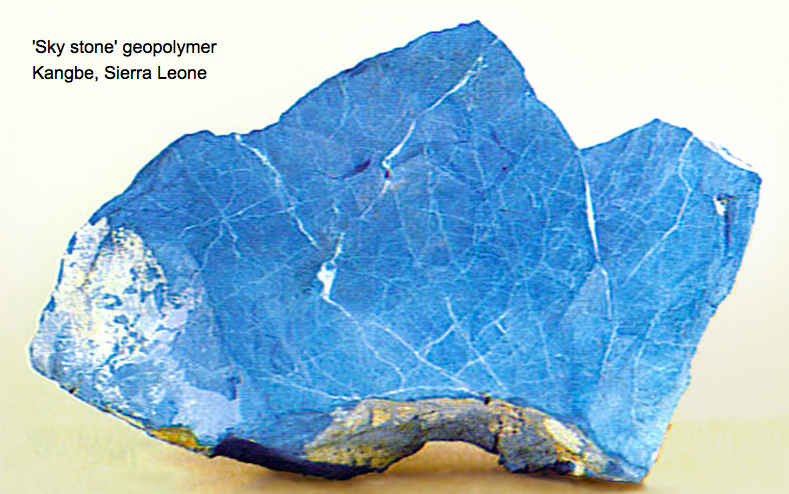
The ancient coastal village of Kangbe, Sierra Leone (8.3819°N, 13.2597°W) is situated 3,230 miles from the Great Pyramid of Giza, Egypt, corresponding to 12.98% of Earth's mean circumference of 24,892 miles. High-precision geopositioning along the resonant band of infrasound standing waves converging along the 13% distance from Giza enables efficient transduction of strong EM fields for bioelectrical qi healing.
Due to this invisible influence that waxes and wanes with solar activity, piezoelectric fires have erupted in multiple homes and office buildings in Freetown, Sierra Leone in October, 2011 and March, 2012, during major solar outbursts just months prior to the Solar Cycle Maximum of December, 2012:
These apparently spontaneous fires on the upper floors of government and police buildings stand among many such unusual events now unfolding, involving the impact of intense electrical ground currents caused by the coronal mass ejections of the Sun. These unusual fires are the direct result of an unrecognized force: ultra-low frequency sound, far below the audible level of most humans... The infrasound which is now being focused onto the Freetown, Sierra Leone vicinity is being transduced by the Orion pyramids of present-day Giza, Egypt, which act as a nonlinear lensing system for resonantly balancing the geomagnetic fields of Earth...
Freetown, Sierra Leone (8.471°N, 13.241°W) is situated 3,225 miles from Giza, or 12.96% of the Earth's mean circumference distance of 24,892 miles, reflecting resonant alignment along the 13% distance band of infrasound. This mathematical relationship of Freetown within the global pyramid network reveals the invisible quantum connections linking such anomalous events related to solar activity. The pattern of intense solar flares and resulting infrasound fires at focal points around the planet will culminate in the intense auroral events of June 22, 2018.
Clearly, the ancient village of Kangbe, Sierra Leone sits within a convergence point of planetary resonance, not far from a sky stone pyramid complex built by gnomes during the Atlantean Era over 13,000 years ago. Eventual excavation of the sky stone gnome pyramid at Kangbe will likely reveal micro-tiled walkways.
Copyright 2018 Alexander R. Putney